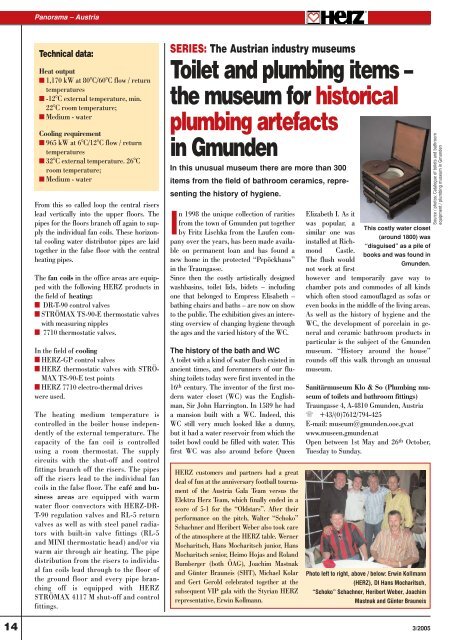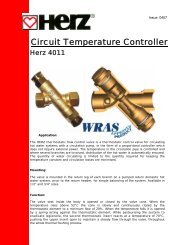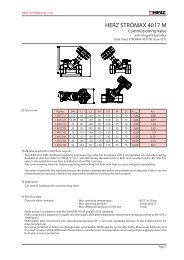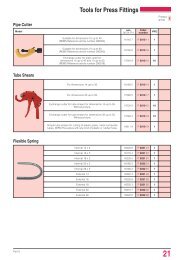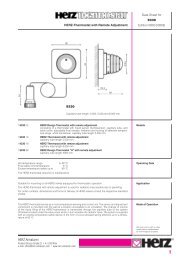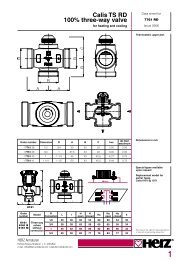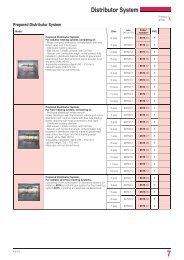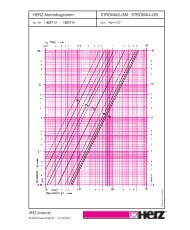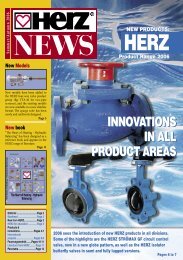Herz Valves UK
Herz Valves UK
Herz Valves UK
Create successful ePaper yourself
Turn your PDF publications into a flip-book with our unique Google optimized e-Paper software.
Panorama – AustriaTechnical data:Heat output■ 1,170 kW at 80°C/60°C flow / returntemperatures■ -12°C external temperature, min.22°C room temperature;■ Medium - waterCooling requirement■ 965 kW at 6°C/12°C flow / returntemperatures■ 32°C external temperature. 26°Croom temperature;■ Medium - waterFrom this so called loop the central riserslead vertically into the upper floors. Thepipes for the floors branch off again to supplythe individual fan coils. These horizontalcooling water distributor pipes are laidtogether in the false floor with the centralheating pipes.The fan coils in the office areas are equippedwith the following HERZ products inthe field of heating:■ DR-T-90 control valves■ STRÖMAX TS-90-E thermostatic valveswith measuring nipples■ 7710 thermostatic valves.In the field of cooling■ HERZ-GP control valves■ HERZ thermostatic valves with STRÖ-MAX TS-90-E test points■ HERZ 7710 electro-thermal driveswere used.The heating medium temperature iscontrolled in the boiler house independentlyof the external temperature. Thecapacity of the fan coil is controlledusing a room thermostat. The supplycircuits with the shut-off and controlfittings branch off the risers. The pipesoff the risers lead to the individual fancoils in the false floor. The café and businessareas are equipped with warmwater floor convectors with HERZ-DR-T-90 regulation valves and RL-5 returnvalves as well as with steel panel radiatorswith built-in valve fittings (RL-5and MINI thermostatic head) and/or viawarm air through air heating. The pipedistribution from the risers to individualfan coils lead through to the floor ofthe ground floor and every pipe branchingoff is equipped with HERZSTRÖMAX 4117 M shut-off and controlfittings.SERIES: The Austrian industry museumsToilet and plumbing items –the museum for historicalplumbing artefactsin GmundenIn this unusual museum there are more than 300items from the field of bathroom ceramics, representingthe history of hygiene.In 1998 the unique collection of raritiesfrom the town of Gmunden put togetherby Fritz Lischka from the Laufen companyover the years, has been made availableon permanent loan and has found anew home in the protected “Pepöckhaus”in the Traungasse.Since then the costly artistically designedwashbasins, toilet lids, bidets – includingone that belonged to Empress Elisabeth –bathing chairs and baths – are now on showto the public. The exhibition gives an interestingoverview of changing hygiene throughthe ages and the varied history of the WC.The history of the bath and WCA toilet with a kind of water flush existed inancient times, and forerunners of our flushingtoilets today were first invented in the16 th century. The inventor of the first modernwater closet (WC) was the Englishman,Sir John Harrington. In 1589 he hada mansion built with a WC. Indeed, thisWC still very much looked like a dunny,but it had a water reservoir from which thetoilet bowl could be filled with water. Thisfirst WC was also around before QueenHERZ customers and partners had a greatdeal of fun at the anniversary football tournamentof the Austria Gala Team versus theElektra <strong>Herz</strong> Team, which finally ended in ascore of 5-1 for the “Oldstars”. After theirperformance on the pitch, Walter “Schoko”Schachner and Heribert Weber also took careof the atmosphere at the HERZ table. WernerMocharitsch, Hans Mocharitsch junior, HansMocharitsch senior, Heimo Hojas and RolandBumberger (both ÖAG), Joachim Mastnakand Günter Brauneis (SHT), Michael Kolarand Gert Gerold celebrated together at thesubsequent VIP gala with the Styrian HERZrepresentative, Erwin Kollmann.Elizabeth I. As itwas popular, asimilar one wasinstalled at RichmondCastle.The flush wouldnot work at firstThis costly water closet(around 1800) was“disguised” as a pile ofbooks and was found inGmunden.however and temporarily gave way tochamber pots and commodes of all kindswhich often stood camouflaged as sofas oreven books in the middle of the living areas.As well as the history of hygiene and theWC, the development of porcelain in generaland ceramic bathroom products inparticular is the subject of the Gmundenmuseum. “History around the house”rounds off this walk through an unusualmuseum.Sanitärmuseum Klo & So (Plumbing museumof toilets and bathroom fittings)Traungasse 4, A-4810 Gmunden, Austria1 +43/(0)7612/794-425E-mail: museum@gmunden.ooe.gv.atwww.museen.gmunden.atOpen between 1st May and 26 th October,Tuesday to Sunday.Photo left to right, above / below: Erwin Kollmann(HERZ), DI Hans Mocharitsch,“Schoko” Schachner, Heribert Weber, JoachimMastnak and Günter BrauneisSource / photos: Catalogue of toilets and bathroomequipment / plumbing museum in Gmunden14 3/2005


